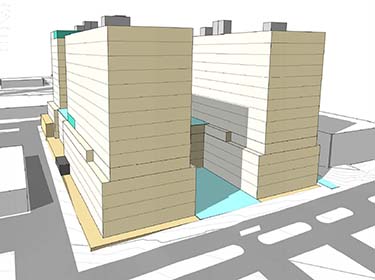|
Subscribe / Renew |
|
|
Contact Us |
|
| ► Subscribe to our Free Weekly Newsletter | |
| home | Welcome, sign in or click here to subscribe. | login |
Architecture & Engineering
| |
 |
March 4, 2021
Not all feasibility studies are created equal
Tiscareno Associates

Barton
|
Feasibility studies are a necessary part of any property acquisition and are often the centerpiece of a sale. If you’re a developer or an architect then you’re likely very familiar with what goes into a typical study: yield, height, stories, areas, parking, unit counts, etc., but how aware are you of the components that impact a study’s reliability? If you’re not sure, don’t worry, you’re not alone.
Not all studies are created equal, so we try to structure feasibility studies into three tiers; each tier, or level of service, provides valuable information but delivers varying degrees of reliability. We help our clients choose right tier for their site so they have the confidence to make the best decision. The following is a quick explanation of each tier. Afterward, I’ll discuss which kind of site/study should be in each tier and end with some tips for creating better studies in general.
FIRST TIER (ENVELOPE STUDY)
What we do:
• Establish factors that determine the buildable envelope.
• Site plan: A general diagram that shows the buildable envelope and assumed access points.
• Area estimates: gross square feet, net rentable square feet (NRSF), and any other data points that can be estimated using a spreadsheet and the buildable envelope.
What we need:
• Location of easements, powerlines and utilities that must remain.
• Assumptions for zoning incentives that affect the buildable envelope.
• Client’s general program goals.
SECOND TIER (MASSING STUDY)
What we do:
• Everything included in the first tier.
• Complete zoning analysis and check of any design guidelines and comprehensive planning as well as estimated street dedications.
• Floor plans, sections and one or two 3D massing views. Floor plans should show feasible egress, preliminary service areas, elevators and parking modules.
• Area estimates: Measurements of rentable/leasable space. Calculated average unit sizes.
What we need:
• Survey, topography.
THIRD TIER (COMPREHENSIVE STUDY)
What we do:
• Everything included in the second tier.
• Demising walls, unit count and mix, individual parking spaces.
• Functional service areas for trash, loading, mechanical — especially electrical services.
What we need:
• Client’s detailed program goals such as amenities, unit count and mix.
So, let’s say you’re looking at a 7,000-square-foot multifamily site in Kirkland. While the envelope of a 1st Tier study might present the area for seven units per floor, the first attempt to actually fit seven, viable units is likely to fail. This might be due to an irregular or narrow site that doesn’t support a normal apartment chassis or because you can’t front a bedroom two feet from a side property line. As a result, the unit count in your proforma drops 30% and you have to start over with another site. This brings us to Rule #1:
The smaller the site, the less reliable the information in a feasibility study will be.
Why? Because there’s little to no tolerance on small sites. Being just a few feet off during feasibility can turn a stack of two studios into a stack of single one-bedrooms. The same can occur with site grading. Parking garage entries can be setback on large sites and only lose 1% of parking. That same setback on a small site might result in a 20% loss.
An office study for 1.5 acres in Federal Way, in contrast to the first site, has a flexible project type on a large, flat site and therefore a higher degree of tolerance. If elements have to move around later on because of things like a large detention vault, there’s room to do so and so the numbers in your proforma can remain stable. In this case, a 1st Tier study is useful. Now, instead of a flat site, let’s add a 30-foot grade change and we find that a 1st Tier study would no longer be useful. So, Rule #2:
The more complicated the site, the less reliable the information in a feasibility study will be.
Why? Variables tend to compound. A building on a flat site has one floor meeting grade. A building on a sloping site has two or three floors meeting different grades, so maintaining a decent ceiling height in an office product means that we need to plan on a lot of ramps to get in and out of the building, which requires more site area, etc. A 2nd Tier study would be the baseline to produce reliable information.
So, sites that can rely on a first tier study are moderate to large and uncomplicated. Sites that can rely on a second tier study are those that are small (but not tiny) and uncomplicated, and those that are moderate and somewhat complicated, and larger sites.
High-rises generally follow the same rules, but often the complexity comes from the building code and the program and not just the physical site.
OTHER CONSIDERATIONS
Besides a discussion about what Tier best suits your site, there are some other rarely mentioned aspects about feasibility studies that you should be aware of.
A feasibility study is an estimate: This might sound like stating the obvious, but a feasibility study does not contain hard numbers. It would be better to present the information in a range, but architects rarely do so. As such, clients should be aware that the information in a feasibility study is almost always on the ideal end. Case in point: parking. I’ve got a 200-foot-long site and 8-foot-wide parking stalls, so I show 25 stalls. Zoning requires one stall per unit so the site yield is 25 apartments, which is the client’s target. Woo. Oh, but wait, I didn’t leave room for shoring, or columns, walls, stairs, fire-pumps, etc. Etc., so by the end of the Design Development phase, there are only 20 stalls and the project is in a pickle. A feasibility study isn’t going to have columns laid out, but it should leave space for them.
Architects can be too optimistic: Why would I show 25 parking stalls? Easy, I want my client to be happy. If I don’t get the numbers you want, you might think that I’m not very clever and go to some other firm, so if you give me a target, I’m going to try and hit it. To do so, I may consciously or unconsciously push the envelope (literally) further than I should, and that’s not what you want. So when you review a study, ask your architect what the conservative numbers are, or better yet, direct them to list them on the study, then discuss feasible ways to increase the yield.
Buying or selling? Whether you are looking to buy or sell the property makes a difference. Sellers typically want their Architects to be optimistic and want the study to be pretty (which costs more). Buyers often don’t care what the study looks like visually, they just want it to be reliable. Communicating your goals clearly can help us tailor the deliverable to your exact needs.
A feasibility study is an investment in an investment. The time and money required to produce a reliable, informative study is a drop in the bucket compared to losing yield down the road. In a competitive real estate market like Western Washington where more and more buyers are purchasing land up front, it is all the more important to get a good study.
Bill Barton is a senior associate at Tiscareno Associates.
Other Stories:
- How to keep the creative spark in a virtual world
- The role of ventilation and healthy air
- It’s the end of the grocery store (as we know it)
- Are American shopping malls boxed-in?
- Influencing human scale, creating a sense of place
- Here are the 3 principles of renovation
- The future of resilient commercial real estate
- Green Lake Community Center aims for inclusivity
- What if you can’t dig your way out of a brownfield cleanup?
- How A/E firms can increase proposal success in 2021
- Workplace wellness through technology
- 4 Living Buildings: collaborative, courageous, open-minded learning
- Foundations for healthy and sustainable urban places
- Parking garages: rethinking your front door
- A changed workforce and the implications for workplaces and cities



